Let's take a journey through the next few pages together. Get to the end, and I promise you'll have a better fitting bra size.
HerRoom CEO/Founder
Breast separation between women’s breasts really does vary widely. This is the horizontal distance between your two breasts at the center of your chest.
How much or how little distance you have between your two breasts can determine if you will be able to achieve touching cleavage (that vertical fold line created when breasts touch), how a bra will fit you, and if an underwire bra will be comfortable.
- TOMIMA
Touching breast separation (also known as "kissing breasts") is where your two breasts are touching or almost touching when you are standing sans a bra. If your breasts are such, you have probably figured out that a bra’s center panel (also called the center gore and center bridge) will have fit issues and probably not rest against your sternum.
The underwires of a traditional underwire bra will probably tilt outward and away from your body at your sternum because again, there is no space available for them to rest against your sternum.
There is also a rare condition called "Symmastia" where the breast tissue between the two breasts is connected (see the Additional Considerations section). This breast separation is not common, but presents bra fit issues as well.
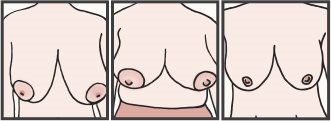
Separated breasts are the most common form of breast separation.
This is where the two breasts, at rest, are not touching one another – generally the breast distance will be 1 to 2 finger’s widths apart.
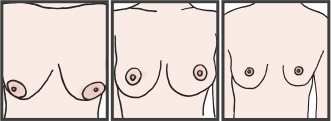
Splayed breast separation is where the breasts are separated, but the separation splays outwards creating a triangle shape between the breasts. So your bra’s center panel (also called center bridge or center gore) needs to be chosen carefully.
If the bridge is not shaped like a triangle, the bottom of the bridge will not be wide enough, and this could cause your underwires between your breasts to tip outward and away from your sternum.
Women who are splayed and have large breasts can find their breasts extending past their sides and getting in the way of arm movement.
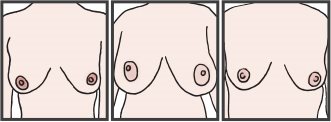
Wide-set breasts are separated breasts but are further apart - generally 3 or more finger’s widths apart at the sternum.
Because of this distance, the ability to create touching cleavage is almost impossible. Underwires can be uncomfortable if you are widely separated, and can cause discomfort in the underarm area if the underwires are not encircling all your breast tissue.
Leaning forward and pushing the underarm breast tissue inside the cups can help. Manipulating the underwire circumference shape and angle can make an underwire bra feel more comfortable.
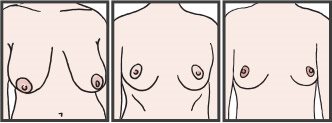
Wide-set/splayed breasts are a combination where your breasts are both wide-set and splayed – there are 3 or more finger-widths between your breasts, and the breasts splay outwards creating a wide triangle shape between the breasts.
The center panel of your bra is, again, key. It needs to be triangle in shape, or barely have a center panel at all. If your breasts are large, you can find them in conflict with the movement of your arms.
Underwires could be uncomfortable under your arms as well. It is very unlikely that wide-set/splayed breasts of any size will be able to create a vertical cleavage line.
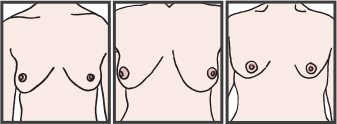
Find your best bra size
Fast
No measuring tape needed
Let's take a journey through the next few pages together. Get to the end, and I promise you'll have a better fitting bra size.
HerRoom CEO/Founder
Find your best
Bra Styles
By Tomima
You know your bra size. But, do you know your breasts? Sounds like a funny question, but certain bras styles and features work better for some breasts and not for others.
Answer the following questions, and I promise your new bras will make you look younger and thinner!
We are sorry we are unable to assist you further.
